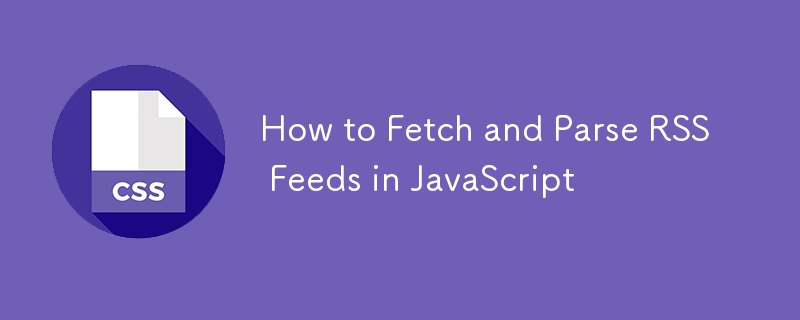How to Fetch and Parse RSS Feeds in JavaScript

This guide demonstrates how to retrieve and process RSS feeds using JavaScript. RSS, an XML-based format, presents a slightly more complex parsing challenge compared to JSON. While many APIs favor JSON, RSS remains prevalent. This tutorial covers validation, network requests using the fetch API, and data manipulation.
First, validate the feed to ensure you're working with a valid response. Then, use fetch to make a network request:
- Fetch the RSS feed URL.
- Parse the response as text.
- Parse the text using
DOMParser(). - Utilize the parsed data.
Here's an example using the fetch API:
const RSS_URL = `https://codepen.io/picks/feed/`;
fetch(RSS_URL)
.then(response => response.text())
.then(str => new window.DOMParser().parseFromString(str, "text/xml"))
.then(data => {
const items = data.querySelectorAll("item");
let html = ``;
items.forEach(el => {
html = `
<img src="/static/imghw/default1.png" data-src="https://img.php.cn/" class="lazy" alt="How to Fetch and Parse RSS Feeds in JavaScript ">
<h2>
<a href="https://www.php.cn/link/b36745962d5a1345e1b6dc85e9a80405" link target="_blank" rel="noopener">
https://www.php.cn/link/b36745962d5a1345e1b6dc85e9a80405"title").textContent}
</a>
</h2>
`;
});
document.body.insertAdjacentHTML("beforeend", html);
});The RSS data structure resembles nested HTML elements. The code above targets <item></item> elements, extracts relevant data (like link and title), and dynamically generates HTML elements to display the feed content.
Alternatively, you can use jQuery for a more concise solution:
const RSS_URL = `https://codepen.io/picks/feed/`;
$.ajax(RSS_URL, {
accepts: { xml: "application/rss xml" },
dataType: "xml",
success: function(data) {
$(data).find("item").each(function() {
const el = $(this);
const template = `
<img src="/static/imghw/default1.png" data-src="https://img.php.cn/" class="lazy" alt="How to Fetch and Parse RSS Feeds in JavaScript ">
<h2>
<a href="https://www.php.cn/link/ea95de08542db1d94fe393abd1a5ce8d" link target="_blank" rel="noopener">
https://www.php.cn/link/ea95de08542db1d94fe393abd1a5ce8d"title").text()}
</a>
</h2>
`;
document.body.insertAdjacentHTML("beforeend", template);
});
}
});For production environments, consider server-side processing with caching to improve performance and security. This approach avoids relying directly on a third-party API for rendering critical content on your website. A server-side approach allows for scheduled updates (using CRON jobs, for example) and provides a faster, more reliable user experience.
The above is the detailed content of How to Fetch and Parse RSS Feeds in JavaScript. For more information, please follow other related articles on the PHP Chinese website!

Hot AI Tools

Undresser.AI Undress
AI-powered app for creating realistic nude photos

AI Clothes Remover
Online AI tool for removing clothes from photos.

Undress AI Tool
Undress images for free

Clothoff.io
AI clothes remover

Video Face Swap
Swap faces in any video effortlessly with our completely free AI face swap tool!

Hot Article

Hot Tools

Notepad++7.3.1
Easy-to-use and free code editor

SublimeText3 Chinese version
Chinese version, very easy to use

Zend Studio 13.0.1
Powerful PHP integrated development environment

Dreamweaver CS6
Visual web development tools

SublimeText3 Mac version
God-level code editing software (SublimeText3)

Hot Topics
 Vue 3
Apr 02, 2025 pm 06:32 PM
Vue 3
Apr 02, 2025 pm 06:32 PM
It's out! Congrats to the Vue team for getting it done, I know it was a massive effort and a long time coming. All new docs, as well.
 Building an Ethereum app using Redwood.js and Fauna
Mar 28, 2025 am 09:18 AM
Building an Ethereum app using Redwood.js and Fauna
Mar 28, 2025 am 09:18 AM
With the recent climb of Bitcoin’s price over 20k $USD, and to it recently breaking 30k, I thought it’s worth taking a deep dive back into creating Ethereum
 Can you get valid CSS property values from the browser?
Apr 02, 2025 pm 06:17 PM
Can you get valid CSS property values from the browser?
Apr 02, 2025 pm 06:17 PM
I had someone write in with this very legit question. Lea just blogged about how you can get valid CSS properties themselves from the browser. That's like this.
 Comparing Browsers for Responsive Design
Apr 02, 2025 pm 06:25 PM
Comparing Browsers for Responsive Design
Apr 02, 2025 pm 06:25 PM
There are a number of these desktop apps where the goal is showing your site at different dimensions all at the same time. So you can, for example, be writing
 A bit on ci/cd
Apr 02, 2025 pm 06:21 PM
A bit on ci/cd
Apr 02, 2025 pm 06:21 PM
I'd say "website" fits better than "mobile app" but I like this framing from Max Lynch:
 Stacked Cards with Sticky Positioning and a Dash of Sass
Apr 03, 2025 am 10:30 AM
Stacked Cards with Sticky Positioning and a Dash of Sass
Apr 03, 2025 am 10:30 AM
The other day, I spotted this particularly lovely bit from Corey Ginnivan’s website where a collection of cards stack on top of one another as you scroll.
 Using Markdown and Localization in the WordPress Block Editor
Apr 02, 2025 am 04:27 AM
Using Markdown and Localization in the WordPress Block Editor
Apr 02, 2025 am 04:27 AM
If we need to show documentation to the user directly in the WordPress editor, what is the best way to do it?
 Why are the purple slashed areas in the Flex layout mistakenly considered 'overflow space'?
Apr 05, 2025 pm 05:51 PM
Why are the purple slashed areas in the Flex layout mistakenly considered 'overflow space'?
Apr 05, 2025 pm 05:51 PM
Questions about purple slash areas in Flex layouts When using Flex layouts, you may encounter some confusing phenomena, such as in the developer tools (d...






